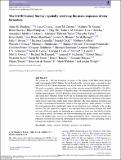The SAMI Galaxy Survey : spatially resolving the main sequence of star formation
Abstract
We present the ∼800 star formation rate maps for the Sydney-AAO Multi-object Integral field spectrograph (SAMI) Galaxy Survey based on H α emission maps, corrected for dust attenuation via the Balmer decrement, that are included in the SAMI Public Data Release 1. We mask out spaxels contaminated by non-stellar emission using the [O iii]/H β, [N ii]/H α, [S ii]/H α, and [O i]/H α line ratios. Using these maps, we examine the global and resolved star-forming main sequences of SAMI galaxies as a function of morphology, environmental density, and stellar mass. Galaxies further below the star-forming main sequence are more likely to have flatter star formation profiles. Early-type galaxies split into two populations with similar stellar masses and central stellar mass surface densities. The main-sequence population has centrally concentrated star formation similar to late-type galaxies, while galaxies >3σ below the main sequence show significantly reduced star formation most strikingly in the nuclear regions. The split populations support a two-step quenching mechanism, wherein halo mass first cuts off the gas supply and remaining gas continues to form stars until the local stellar mass surface density can stabilize the reduced remaining fuel against further star formation. Across all morphologies, galaxies in denser environments show a decreased specific star formation rate from the outside in, supporting an environmental cause for quenching, such as ram-pressure stripping or galaxy interactions.
Citation
Medling , A M , Cortese , L , Croom , S M , Green , A W , Groves , B , Hampton , E , Ho , I-T , Davies , L J M , Kewley , L J , Moffett , A J , Schaefer , A L , Taylor , E , Zafar , T , Bekki , K , Bland-Hawthorn , J , Bloom , J V , Brough , S , Bryant , J J , Catinella , B , Cecil , G , Colless , M , Couch , W J , Drinkwater , M J , Driver , S P , Federrath , C , Foster , C , Goldstein , G , Goodwin , M , Hopkins , A , Lawrence , J S , Leslie , S K , Lewis , G F , Lorente , N P F , Owers , M S , McDermid , R , Richards , S N , Sharp , R , Scott , N , Sweet , S M , Taranu , D S , Tescari , E , Tonini , C , Sande , J V D , Walcher , C J & Wright , A 2018 , ' The SAMI Galaxy Survey : spatially resolving the main sequence of star formation ' , Monthly Notices of the Royal Astronomical Society , vol. 475 , no. 4 , pp. 5194-5214 . https://doi.org/10.1093/mnras/sty127
Publication
Monthly Notices of the Royal Astronomical Society
Status
Peer reviewed
ISSN
0035-8711Type
Journal article
Collections
Items in the St Andrews Research Repository are protected by copyright, with all rights reserved, unless otherwise indicated.

